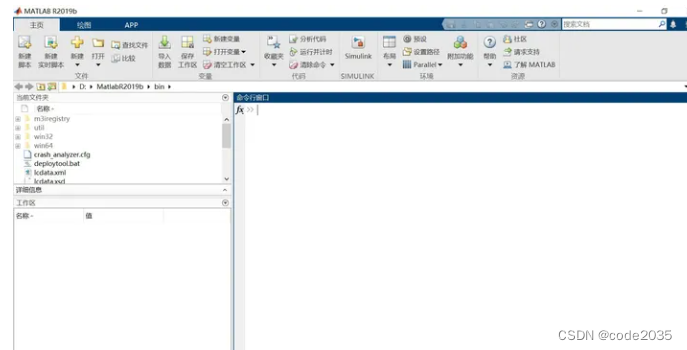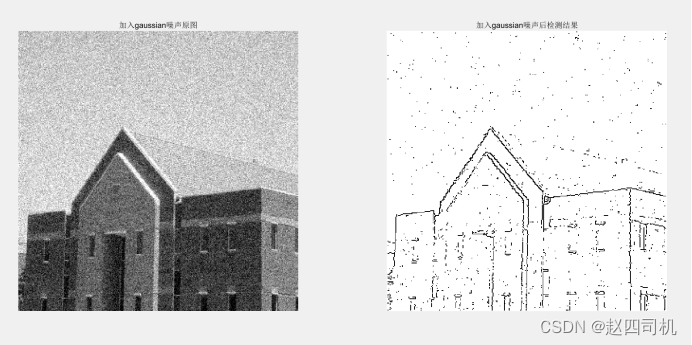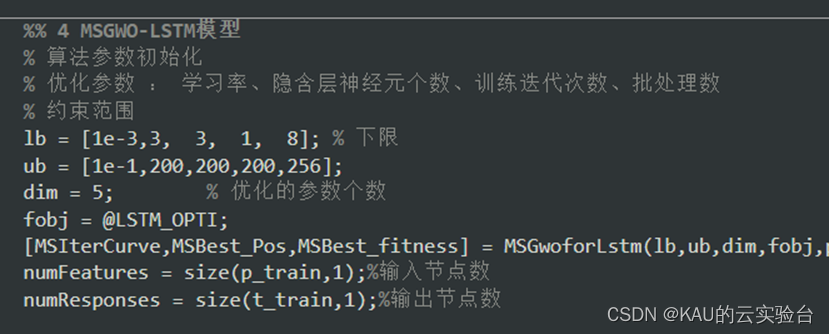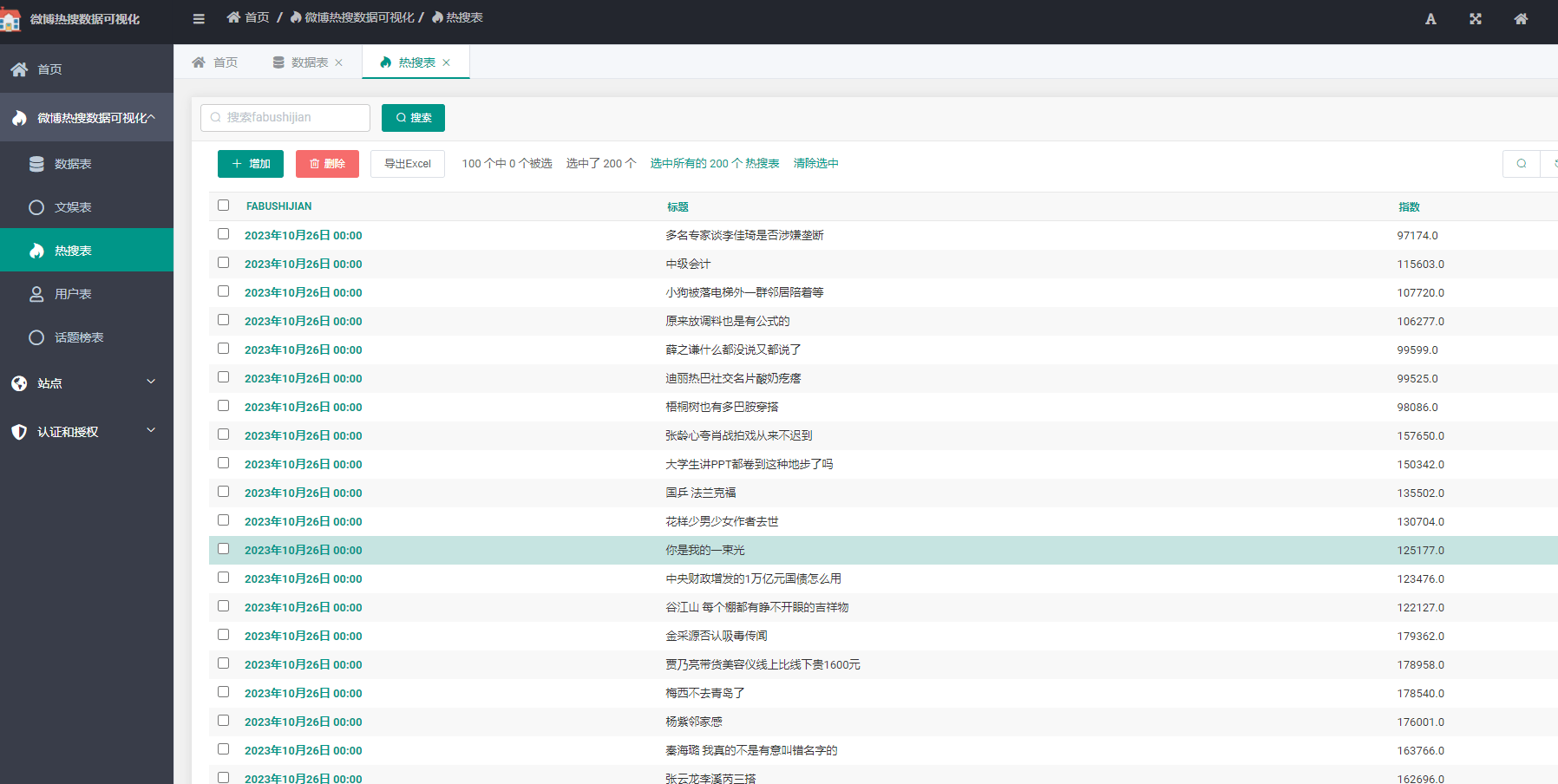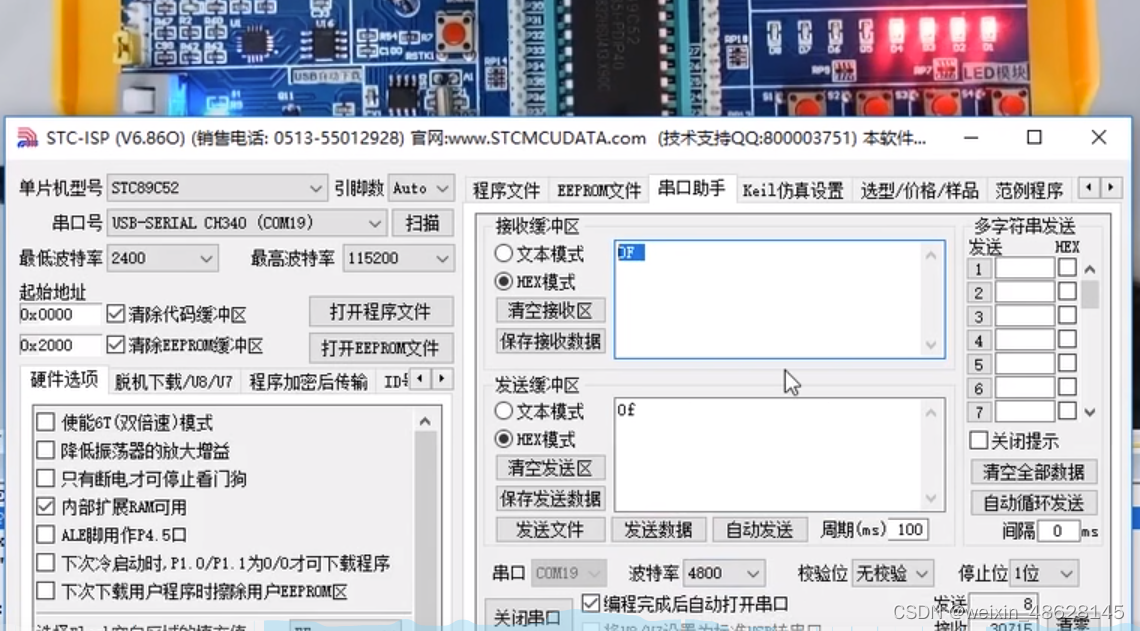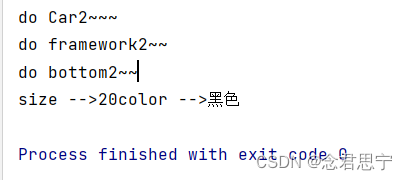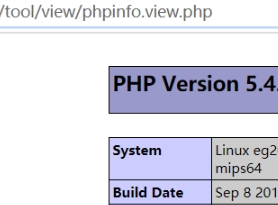原始 Markdown文档、Visio流程图、XMind思维导图见:https://github.com/LiZhengXiao99/Navigation-Learning
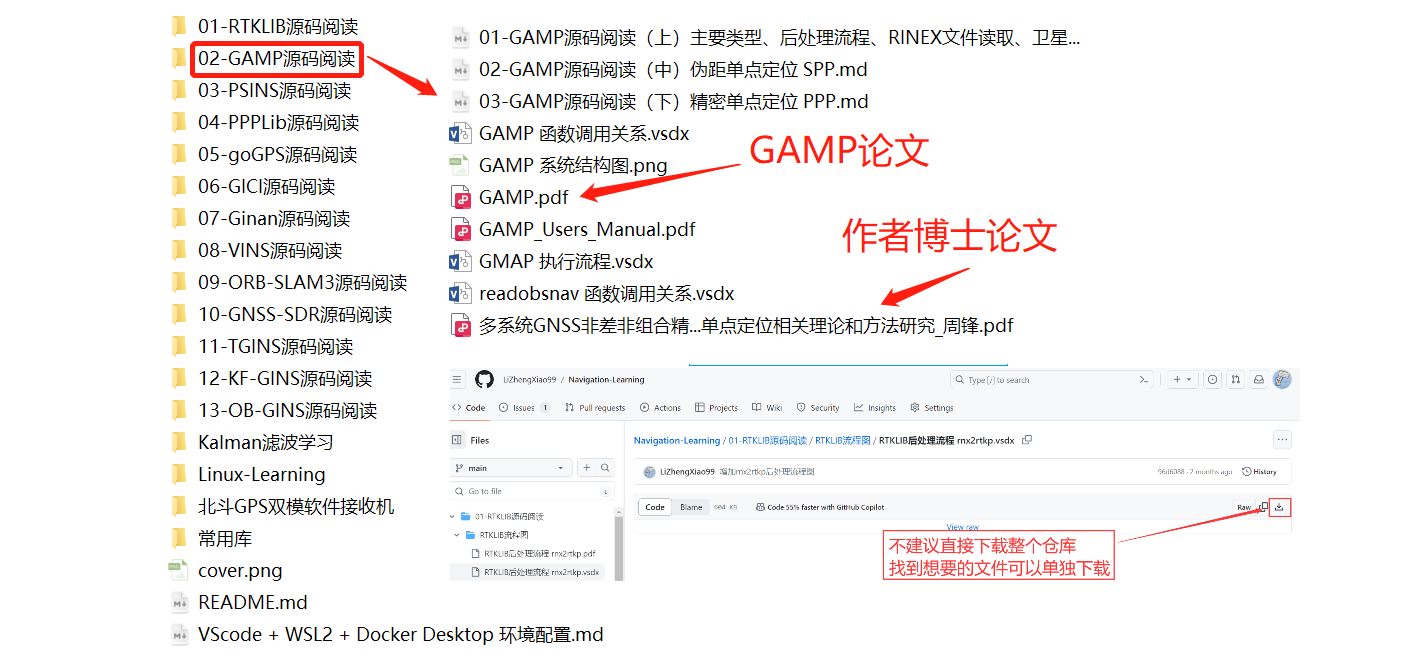
文章目录
- 一、GAMP 简介
- 1、程序概述
- 2、工具箱介绍
- 3、函数调用关系
- 4、程序执行流程
- 二、基础类型定义
- 1、宏定义
- 2、结构体定义
- 3、矩阵、向量、最小二乘、卡尔曼滤波
- 4、时间和字符串
- 5、坐标系统
- 6、卫星系统、观测值
- 7、配置选项
- 三、后处理
- 1、main()
- 2、proccfgfile():处理配置文件
- 3、procOneFile():处理单个观测值文件
- 4、gampPos():开始后处理
- 5、excses():执行后处理解算
- 6、procpos():进行定位解算
- 7、rtkpos():逐历元解算
- 四、RINEX 文件读取
- 1、readobsnav():Rinex 文件读取主入口函数
- 2、readrnxfile():传入文件路径,读取起止时间内数据
- 4、readrnxfp():传入文件描述符,调用对应的读取函数
- 5、readrnxh():读取文件头
- 6、观测文件读取
- 1. decode_obsh():解析观测数据文件头
- 2. readrnxobs():读取o文件中全部观测值数据
- 3. readrnxobsb():读取一个观测历元的观测数据
- 4. decode_obsepoch():解码历元首行数据
- 5. decode_obsdata():读取一个历元内一颗卫星的观测值
- 7、星历文件读取
- 1. decode_navh()、decode_gnavh()、decode_hnavh()
- 2. readrnxnav():读取星历文件,添加到nav结构体中
- 3. readrnxnavb():读取一个历元的星历数据,添加到 eph 结构体中
- 8、钟差文件读取
- 五、卫星位置钟差计算
- 1、satposs_rtklib()
- 2、ephclk()
- 3、ephpos()
- 4、peph2pos()
一、GAMP 简介
1、程序概述
GAMP 全称 (GNSS Analysis software for Multi-constellation and multi-frequency Precise positioning),在 RTKLIB 的基础上,将一些多余的函数、代码简洁化,精简出后处理 PPP 部分,并对算法进行改进增强。简化后代码比 RTKLIB 原版还要简单,对初学者非常友好,在我接触过的导航定位开源程序中算是最简单的。使用也很方便,软件包里提供了 VS 工程,和组织好的配置文件、数据文件,简单改改文件路径就能算出结果。
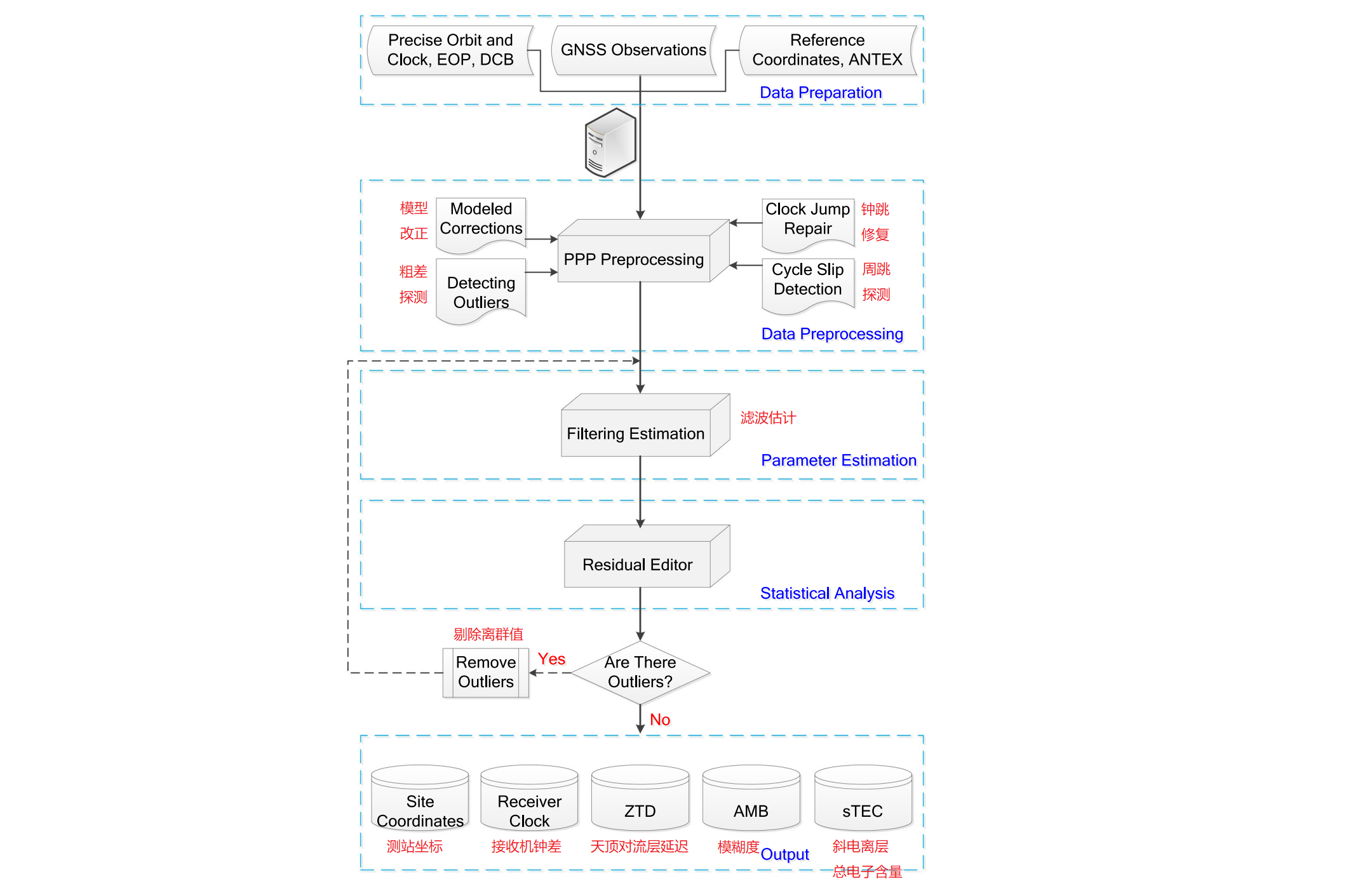
2、工具箱介绍
-
MatPlot:
3、函数调用关系
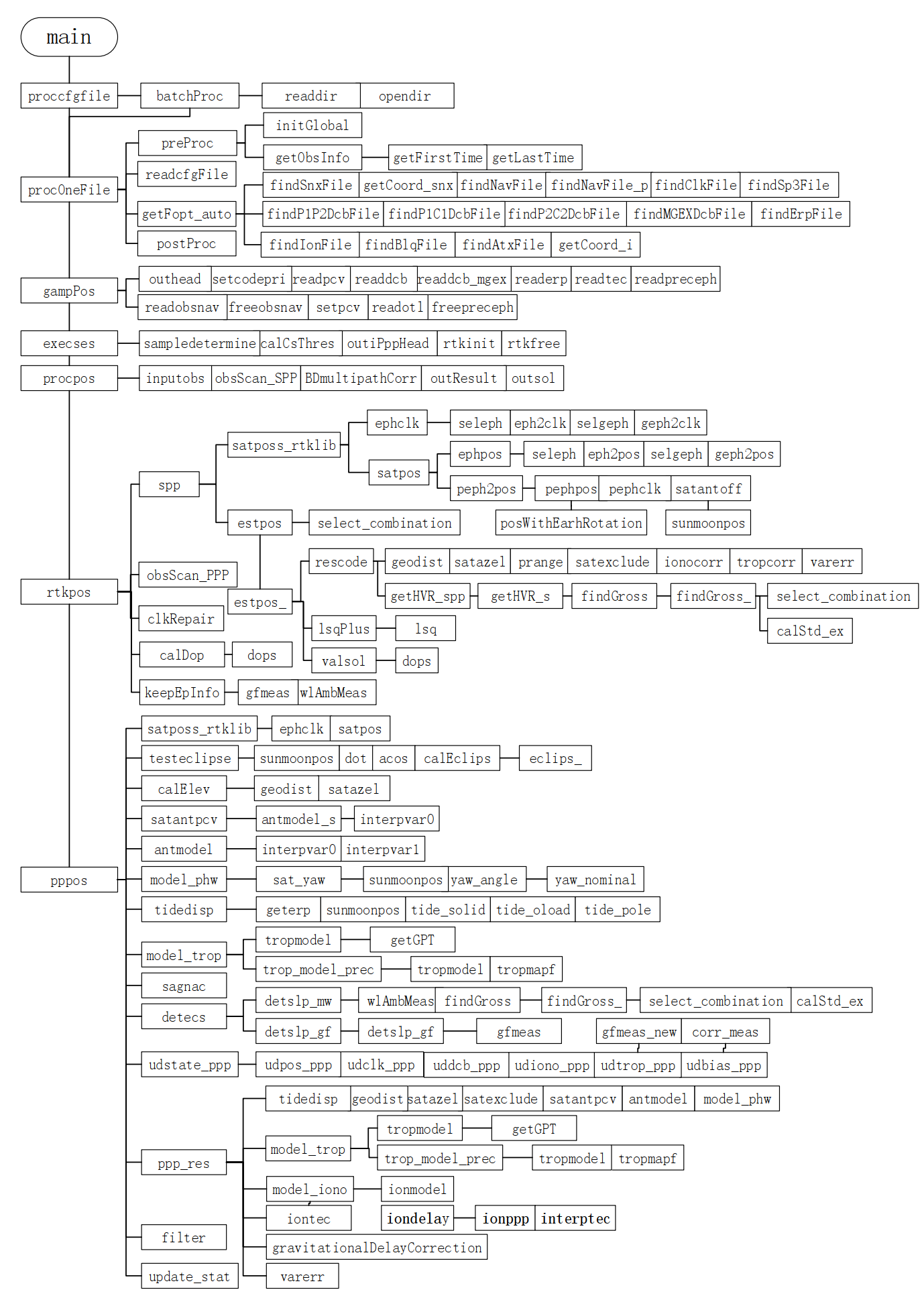
4、程序执行流程
二、基础类型定义
1、宏定义
大部分沿用 RTKLIB,做了少量拓展
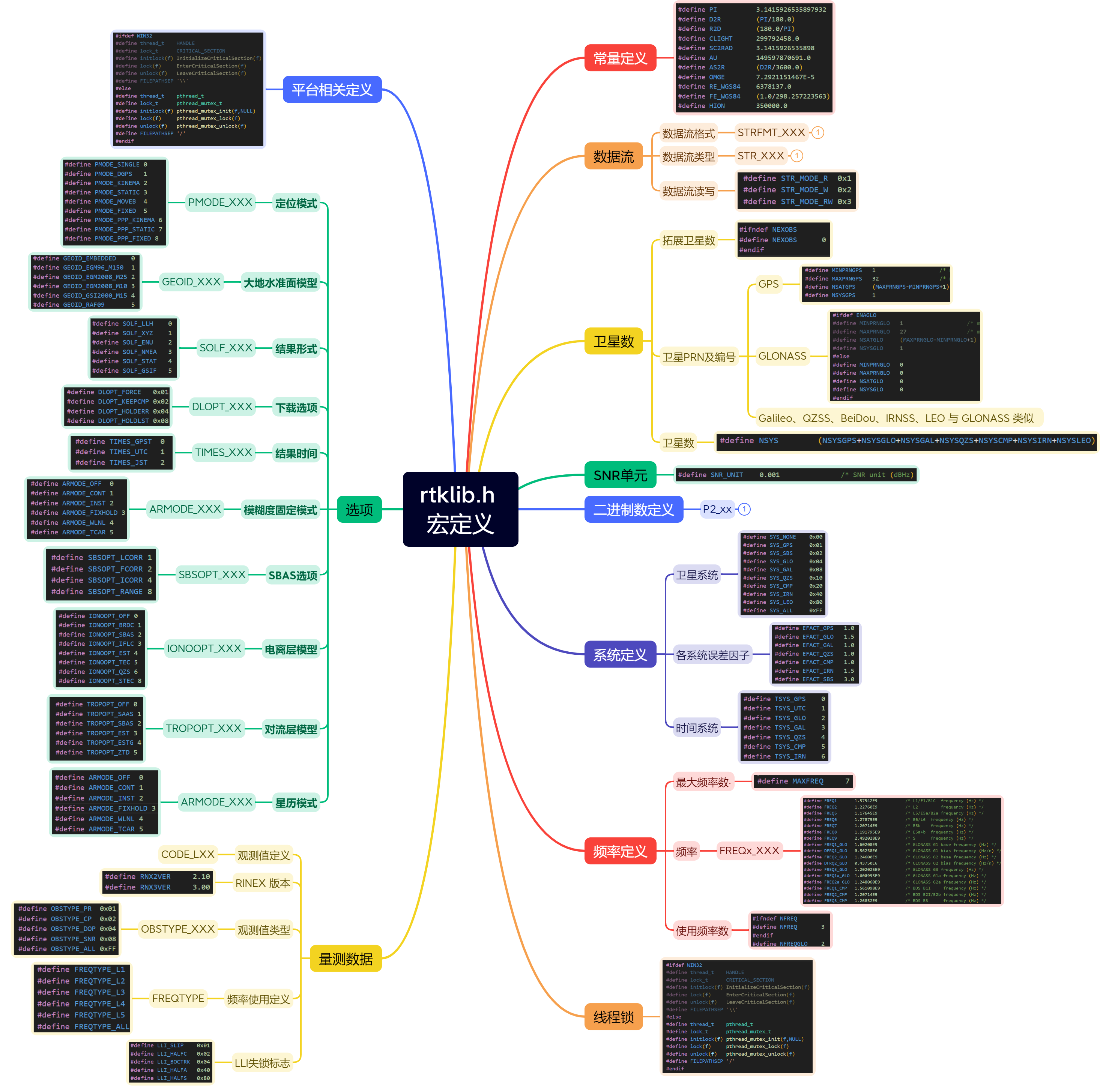
2、结构体定义
大部分沿用 RTKLIB,做了少量拓展

3、矩阵、向量、最小二乘、卡尔曼滤波
- GAMP 中用 double 类型一维数组表示矩阵,不能自动识别矩阵的行列数,每次传矩阵的时候都要传入行数 n、列数 m。
- 用矩阵的时候要先 malloc 开辟空间,用完记得 free 释放空间。
- 要能熟练计算矩阵加减乘除转置。
- 矩阵求逆用的 LU 分解法,时间复杂度 O 3 O^3 O3 ,对于大规模的矩阵,如果利用矩阵的稀疏性和对称性等特性,而且当使用不完全分解方法(例如,只计算到一定程度或使用截断技术)时,LU 分解的效率会更高。
matprint()很常用,调试的时候不好直接看的矩阵元素的值,得输出到终端或者文件再看。

4、时间和字符串
- GAMP 中时间一般都以
gtime_t类型存储,为了提高时间表示的精度,分开存 GPST 时间的整秒数和不足一秒的部分。 - 经常需要做年月日时分秒、周+周内秒、GPST 三种时间之间的转换;想输出北京时间的时候要加 8 小时。
- BDT、GLONASST 不怎么用,读完文件就转为 GPS 时间了。
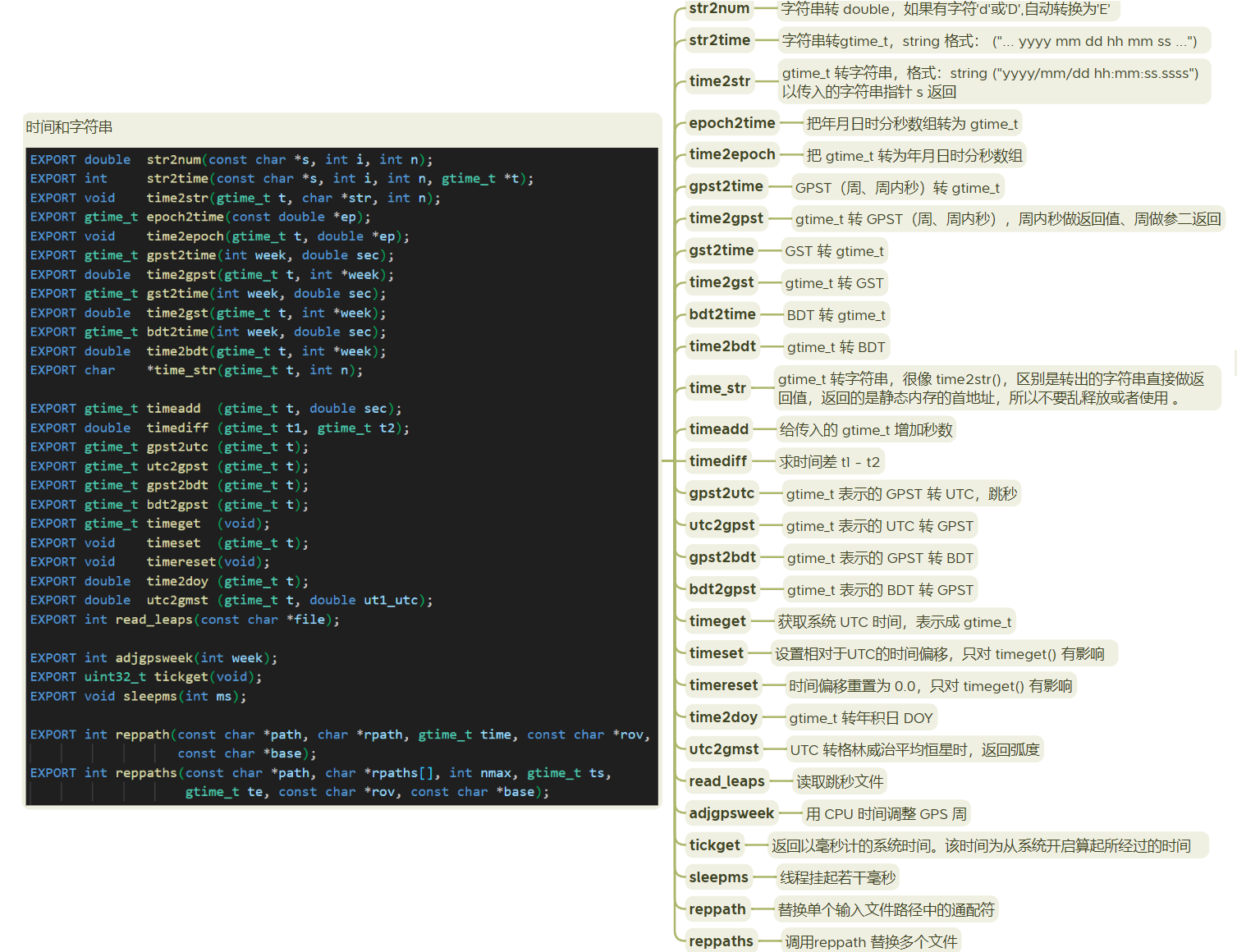
5、坐标系统
- ECI 用的很少,只在
sunmoonpos()函数中计算太阳月亮时候用到了,不用太关注。 - ENU、ECEF、LLH 三套坐标系都频繁使用,要熟练掌握他们直接的转换,包括协方差的转换
- ENU 是局部相对坐标系,以某一个 LLH 坐标为原点,坐标转换的时候要传入这个 LLH 坐标。
- ENU 常用
e表示、ECEF 常用r表示、LLH 常用pos表示。

6、卫星系统、观测值
- 卫星系统表示:
- 表示卫星系统的字母:GRECJIS。
- 7 位二进制码表示,对应位写 1 表示有对应的系统,做与运算可加系统。
- 卫星的表示:
- 可以表示为各系统的卫星ID(系统缩写+PRN):B02、C21。
- 也可表示为连续的 satellite number。
- 观测值类型:
- C:伪距、D:多普勒、L:载波相位、S:载噪比。
CODE_XXX:观测值类型定义,用一串连续的数字表示。sigind_t:表示每种卫星系统的载波类型和观测值类型 ,每种类型的系统其实对应的就是一个sigind_t结构体。
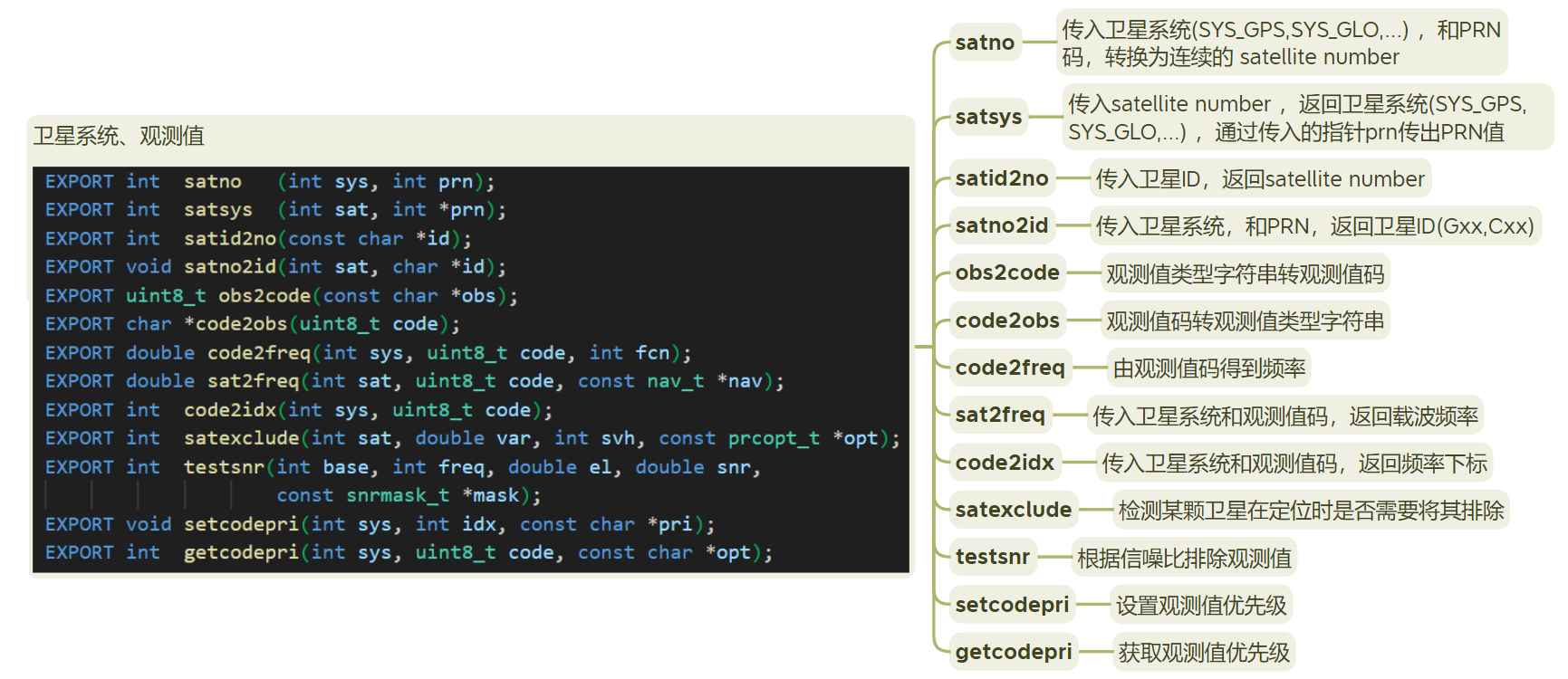
7、配置选项
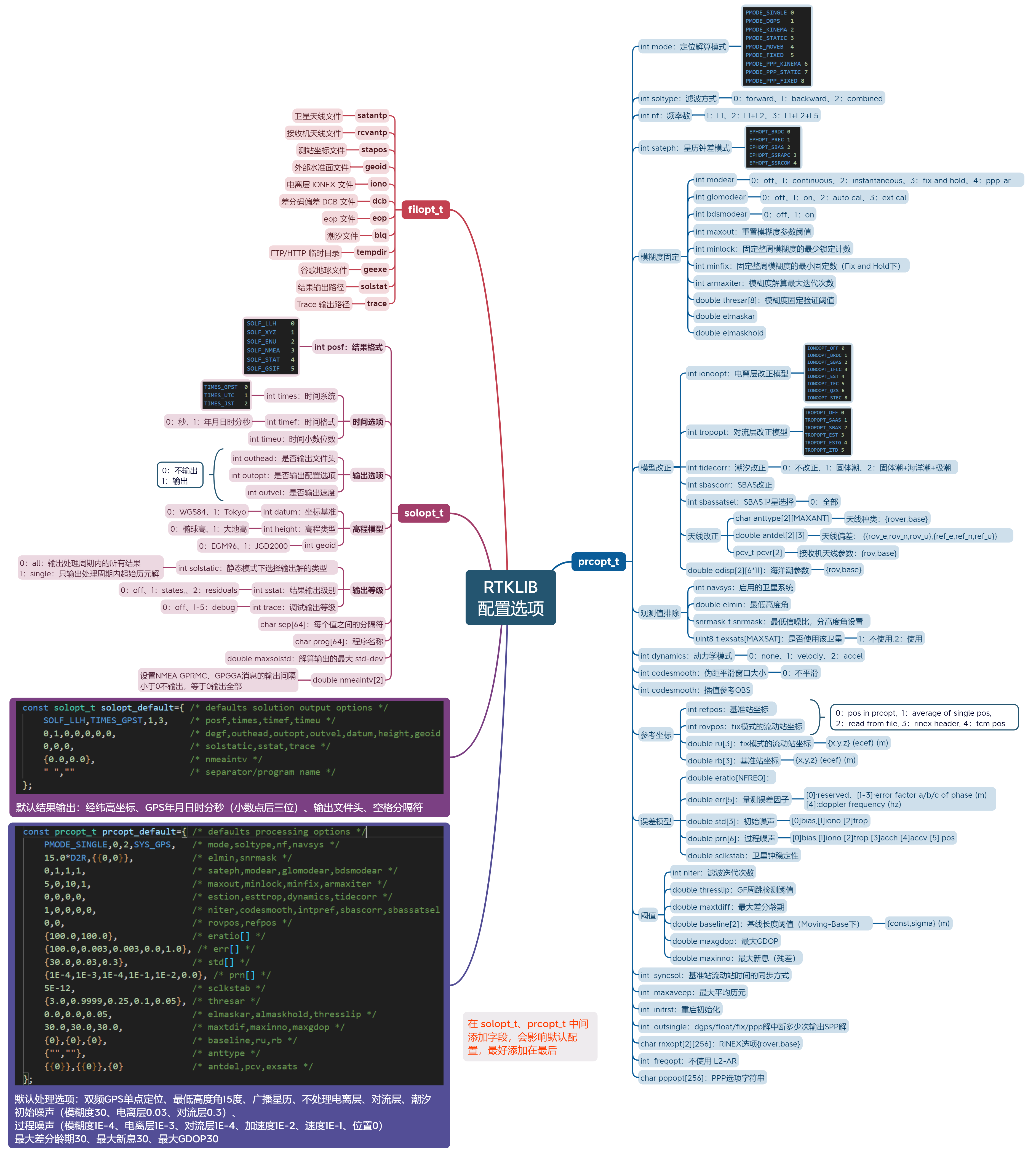
三、后处理
1、main()
程序从 main.c 的 main() 函数开始执行,整个程序都在 t1=clock() 和 t2=clock() 中执行,求得t2-t1为程序执行时间。main() 函数接收传入的命令行参数即 gamp.cfg 的文件路径,如果传入了参数,调用 proccfgfile() 进行下一步处理。
- VS 中:在 项目属性-调试-命令行参数 中指定命令行参数。
- Windows 的文件路径中一般用
\,且为了避免转义需要写成\\。linux一般用/。
int main(int argc, char **argv)
{
//char cfgfile[1000]="C:\\mannual_GAMP\\Examples\\2017244\\gamp.cfg";
char *cfgfile;
long t1,t2;
t1=clock();
if (argc==1) {
printf("\n * The input command-line parameter indicating configure file is lost, please check it!\n");
return 0;
}
else {
cfgfile=argv[1];
}
// 调用 proccfgfile() 处理配置文件
/* find processing configure file */
proccfgfile(cfgfile);
t2=clock();
printf("\n * The total time for running the program: %6.3f seconds\n%c",(double)(t2-t1)/CLOCKS_PER_SEC,'\0');
//printf("Press any key to exit!\n");
//getchar();
return 0;
}
2、proccfgfile():处理配置文件

proccfgfile() 函数先将 PPP_Glo 结构体初始化,将处理方式,输入输出文件路径赋空值。打开传入的 gamp.cfg 文件,获取观测值文件路径和处理方式,根据观测文件的数量调用对应的函数:
- 单个观测文件调用
procOneFile()进行下一步处理; - 如果有多个文件调用
batchProc()进行批量处理,batchProc()会打开文件夹,循环查找文件夹中的观测值O文件,调用procOneFile()进行下一步处理。
观测值
O文件的后缀有两种,一种是直接.O结尾,一种是.ddO结尾,dd表示年份后两位。
static int proccfgfile(char cfgfile[])
{
FILE *fp=NULL;
char *p,tmp[MAXSTRPATH]={'\0'};
// 将 PPP_Glo 结构体初始化,将处理方式、输入输出文件路径赋空值
//initialization
PPP_Glo.prcType=-1;
PPP_Glo.outFolder[0]='\0';
PPP_Glo.inputPath[0]='\0';
// 打开传入的 gamp.cfg 配置文件
if ((fp=fopen(cfgfile,"r"))==NULL) {
printf("*** ERROR: open configure file failed, please check it!\n");
return 0;
}
while (!feof(fp)) {
tmp[0]='\0';
fgets(tmp,MAXSTRPATH,fp);
if ((tmp!=NULL)&&(tmp[0]=='#')) continue;
// 获取观测值文件路径和处理方式
if (strstr(tmp,"obs file/folder")) {
p=strrchr(tmp,'=');
sscanf(p+1,"%d",&PPP_Glo.prcType);
tmp[0]='\0';
if (fgets(tmp,MAXSTRPATH,fp)) {
p=strrchr(tmp,'=');
sscanf(p+1,"%[^,]",PPP_Glo.inputPath);
// 调用 trimSpace() 去除空格,调用 cutFilePathSep() 去除文件末尾的 /
trimSpace(PPP_Glo.inputPath);
cutFilePathSep(PPP_Glo.inputPath);
}
else {
printf("*** ERROR: read obs files path error!");
return 0;
}
break;
}
}
fclose(fp);
if (PPP_Glo.prcType<0||PPP_Glo.prcType>2) {
printf("*** ERROR: read obs files path error!");
return 0;
}
if (PPP_Glo.prcType==0) // 单个观测文件调用 procOneFile() 进行下一步处理
procOneFile(PPP_Glo.inputPath,cfgfile,0,1);
else if (PPP_Glo.prcType==1) // 多个文件调用 batchProc() 进行批量处理
batchProc(PPP_Glo.inputPath,cfgfile);
return 1;
}
3、procOneFile():处理单个观测值文件

-
先调用
preProc()预处理:通过调用initGlobal()初始化PPP_Glo结构体;调用getObsInfo()读取观测O文件的一部分,获取起止时间、文件版本、天线种类等基础信息;为filopt.inf、filopt.outf开辟内存空间。 -
调用
readcfgFile()读取整个配置文件,通过strstr(line,"start_time")匹配处理选项,存储到prcOpt_Ex、prcopt。 -
调用
getFopt_auto(),通过调用findClkFile()、findNavFile(),根据后缀名自动查找各种 PPP 解算所需的文件,将文件路径存到fopt->inf中。 -
调用
gampPos()进行下一步处理;处理结束,调用postProc()释放filopt.inf、filopt.outf内存空间。
extern void procOneFile(char file[], char cfgfile[], int iT, int iN)
{
procparam_t pparam;
gtime_t t={0},ts=t,te=t ;
long t1,t2;
t1=clock();
// 先调用 preProc() 预处理:
// 其通过调用 initGlobal() 初始化 PPP_Glo 结构体
// 调用 getObsInfo() 读取观测O文件的一部分,获取起止时间、文件版本、天线种类等基础信息
// 为 filopt.inf、filopt.outf 开辟内存空间
preProc(file,&pparam,&ts,&te);
printf(" * Processing the %dth", iN);
if (iT>0) printf("/%d", iT);
printf(" ofile: %s\n", PPP_Glo.ofileName_ful);
// 调用 readcfgFile() 读取整个配置文件,通过 strstr(line,"start_time") 匹配处理选项,存储到 prcOpt_Ex、prcopt
//read configure file
readcfgFile(cfgfile,&pparam.prcopt,&pparam.solopt,&pparam.filopt);
//single-, dual- or triple-frequency?
if (pparam.prcopt.ionoopt==IONOOPT_IF12||pparam.prcopt.ionoopt==IONOOPT_UC1) {
if (pparam.prcopt.nf!=1) {
printf("*** ERROR: Number of frequencies Error! Please set inpfrq=1.\n");
return;
}
}
if (pparam.prcopt.ionoopt==IONOOPT_UC12) {
if (pparam.prcopt.nf!=2) {
printf("*** ERROR: Number of frequencies Error! Please set inpfrq=2.\n");
return;
}
}
//processing time set
if (!PPP_Glo.prcOpt_Ex.bTsSet) PPP_Glo.prcOpt_Ex.ts=ts;
else if (timediff(ts,PPP_Glo.prcOpt_Ex.ts)>0) PPP_Glo.prcOpt_Ex.ts=ts;
if (!PPP_Glo.prcOpt_Ex.bTeSet) PPP_Glo.prcOpt_Ex.te=te;
else if (timediff(te,PPP_Glo.prcOpt_Ex.te)<0) PPP_Glo.prcOpt_Ex.te=te;
// 调用 getFopt_auto() ,通过调用 findClkFile()、findNavFile(),根据后缀名自动查找各种 PPP 解算所需的文件,将文件路径存到 fopt->inf 中
//automatically matches the corresponding files
getFopt_auto(file,PPP_Glo.obsDir,ts,te,pparam.prcopt,pparam.solopt,&pparam.filopt);
// 调用 gampPos() 进行下一步处理
// post processing positioning
gampPos(PPP_Glo.prcOpt_Ex.ts, PPP_Glo.prcOpt_Ex.te, 0.0, 0.0,
&pparam.prcopt,&pparam.solopt,&pparam.filopt);
// 调用 postProc() 释放 filopt.inf、filopt.outf 内存空间
postProc(pparam);
t2=clock();
sprintf(PPP_Glo.chMsg," * The program runs for %6.3f seconds\n%c",(double)(t2-t1)/CLOCKS_PER_SEC,'\0');
outDebug(OUTWIN,OUTFIL,0);
printf("/***************************** OK *****************************/\n\n\n");
if (PPP_Glo.outFp[OFILE_DEBUG]) {
fclose(PPP_Glo.outFp[OFILE_DEBUG]);
PPP_Glo.outFp[OFILE_DEBUG]=NULL;
}
}
4、gampPos():开始后处理

-
先调用
outhead()写输出文件的文件头。 -
调用
setcodepri()设置观测值优先级。 -
调用
readdcb()、readobsnav()、readpreceph()等函数读取文件。 -
文件读取完之后,调用
execses()进行下一步处理。 -
处理完之后调用
freeobsnav()、freepreceph()释放内存空间。
extern int gampPos(gtime_t ts, gtime_t te, double ti, double tu, prcopt_t *popt,
const solopt_t *sopt, filopt_t *fopt)
{
int i,j,stat=0,index[MAXINFILE]={0};
// 先调用 outhead() 写输出文件的文件头
/* write header to output file */
if (!outhead(fopt->outf,popt,sopt,PPP_Glo.outFp,MAXOUTFILE))
return 0;
for (i=0;i<MAXOUTFILE;i++) {
if (fopt->outf[i]&&strlen(fopt->outf[i])>2)
PPP_Glo.outFp[i]=openfile(fopt->outf[i]);
else
PPP_Glo.outFp[i]=NULL;
}
// 调用 setcodepri() 设置观测值优先级
/* set rinex code priority for precise clock */
if (PMODE_PPP_KINEMA<=popt->mode)
setcodepri(SYS_GPS,1,popt->sateph==EPHOPT_PREC?"PYWC":"CPYW");
// 调用 readdcb()、readobsnav()、readpreceph() 等函数读取文件
/* read satellite antenna parameters */
if (*fopt->antf&&!(readpcv(fopt->antf,&pcvss))) {
printf("*** ERROR: no sat ant pcv in %s\n",fopt->antf);
return -1;
}
/* read dcb parameters */
for (i=0;i<MAXSAT;i++) for (j=0;j<3;j++) {
navs.cbias[i][j]=0.0;
}
if (*fopt->p1p2dcbf)
readdcb(fopt->p1p2dcbf,&navs);
if (*fopt->p1c1dcbf)
readdcb(fopt->p1c1dcbf,&navs);
if (*fopt->p2c2dcbf)
readdcb(fopt->p2c2dcbf,&navs);
if (*fopt->mgexdcbf&&(popt->navsys&SYS_CMP||popt->navsys&SYS_GAL))
readdcb_mgex(fopt->mgexdcbf,&navs,PPP_Glo.prcOpt_Ex.ts);
/* read erp data */
if (*fopt->eopf) {
if (!readerp(fopt->eopf,&navs.erp)) {
printf("ERROR: no erp data %s\n",fopt->eopf);
}
}
/* read ionosphere data file */
if (*fopt->ionf&&(popt->ionoopt==IONOOPT_TEC||((popt->ionoopt==IONOOPT_UC1||popt->ionoopt==IONOOPT_UC12)&&
PPP_Glo.prcOpt_Ex.ion_const)))
readtec(fopt->ionf,&navs,1);
for (i=0;i<MAXINFILE;i++) index[i]=i;
/* read prec ephemeris */
readpreceph(fopt->inf,MAXINFILE,popt,&navs);
/* read obs and nav data */
if (!readobsnav(ts,te,ti,fopt->inf,index,MAXINFILE,popt,&obss,&navs,stas)) {
freeobsnav(&obss,&navs);
return 0;
}
if (PPP_Glo.nEpoch<=1) {
strcpy(PPP_Glo.chMsg,"PPP_Glo.nEpoch<=1!\n\0");
printf("%s",PPP_Glo.chMsg);
freeobsnav(&obss,&navs);
return 0;
}
//read igs antex only once, and save the elements in 'pcvss'
/* set antenna paramters */
setpcv(obss.data[0].time,popt,&navs,&pcvss,&pcvss,stas);
/* read ocean tide loading parameters */
if (popt->mode>PMODE_SINGLE&&fopt->blqf) {
readotl(popt,fopt->blqf,stas);
}
// 调用 execses() 进行下一步处理
//next processing
stat=execses(popt,sopt,fopt);
// 处理完之后调用调用 freeobsnav()、freepreceph() 释放内存空间
/* free obs and nav data */
freeobsnav(&obss,&navs);
/* free prec ephemeris and sbas data */
freepreceph(&navs);
/* free antenna parameters */
if (pcvss.pcv) {free(pcvss.pcv); pcvss.pcv=NULL; pcvss.n=pcvss.nmax=0;}
if (pcvsr.pcv) {free(pcvsr.pcv); pcvsr.pcv=NULL; pcvsr.n=pcvsr.nmax=0;}
/* free erp data */
if (navs.erp.data) {free(navs.erp.data); navs.erp.data=NULL; navs.erp.n=navs.erp.nmax=0;}
if (PPP_Glo.outFp[OFILE_IPPP]) fprintf(PPP_Glo.outFp[OFILE_IPPP],"-PPP_BLOCK\n");
for (i=0;i<MAXOUTFILE;i++) {
if (i==OFILE_DEBUG) continue;
if (PPP_Glo.outFp[i]) {
fclose(PPP_Glo.outFp[i]);
PPP_Glo.outFp[i]=NULL;
}
}
return stat;
}
5、excses():执行后处理解算

- 先调用
sampledetermine()获取观测值采用间隔(解算频率)。 - 调用
calCsThres()获取周跳检测的阈值,调用rtkinit()初始化rtk结构体。 - 调用
procpos()进行下一步处理。 - 处理完之后调用
rtkfree()释放rtk结构体。
static int execses(prcopt_t *popt, const solopt_t *sopt, filopt_t *fopt)
{
rtk_t rtk;
// 先调用 sampledetermine() 获取观测值采用间隔(解算频率),周跳检测会用到
//to determine the thresh values for cycle slip detection
PPP_Glo.sample=sampledetermine(popt);
// 调用 calCsThres() 获取周跳检测的阈值
if (fabs(PPP_Glo.prcOpt_Ex.csThresGF)<0.01||fabs(PPP_Glo.prcOpt_Ex.csThresMW)<0.01)
calCsThres(popt,PPP_Glo.sample);
// 调用 rtkinit() 初始化 rtk 结构体
rtkinit(&rtk,popt);
if (PPP_Glo.outFp[OFILE_IPPP]) outiPppHead(PPP_Glo.outFp[OFILE_IPPP],rtk);
// 根据前向滤波、后向滤波、前后向结合,以不同的方式调用 procpos() 进行下一步处理
if (popt->soltype==0) { /* forward */
PPP_Glo.revs=0;
PPP_Glo.iObsu=0;
PPP_Glo.iEpoch=0;
procpos(&rtk,popt,sopt,0);
}
else if (popt->soltype==1) { /* backward */
PPP_Glo.revs=1;
PPP_Glo.iObsu=obss.n-1;
PPP_Glo.iEpoch=PPP_Glo.nEpoch;
procpos(&rtk,popt,sopt,0);
}
else { /* combined */
PPP_Glo.solf=(sol_t *)malloc(sizeof(sol_t)*PPP_Glo.nEpoch);
PPP_Glo.solb=(sol_t *)malloc(sizeof(sol_t)*PPP_Glo.nEpoch);
if (PPP_Glo.solf&&PPP_Glo.solb) {
}
else
printf("error : memory allocation");
free(PPP_Glo.solf); PPP_Glo.solf=NULL;
free(PPP_Glo.solb); PPP_Glo.solb=NULL;
}
// 处理完之后调用 rtkfree() 释放 rtk 结构体
rtkfree(&rtk);
return 0;
}
6、procpos():进行定位解算

- 循环调用
inputobs()传入一个历元的观测值。 - 调用
obsScan_SPP()观测值检测。 - 调用
BDmultipathCorr()修正北斗伪距延迟。 - 调用
rtkpos()进行下一步处理。 - 处理完之后调用
outResult()、outsol()输出结果。
static void procpos(rtk_t *rtk,const prcopt_t *popt,const solopt_t *sopt,int mode)
{
sol_t sol={{0}};
gtime_t time={0};
obsd_t obs[MAXOBS];
int i,j,k=0,nep=0,nobs,n,solstatic,pri[]={0,1,2,3,4,5,1,6};
solstatic=sopt->solstatic&&popt->mode==PMODE_PPP_STATIC;
// 循环调用 inputobs() 传入一个历元的观测值
/* processing epoch-wise */
while ((nobs=inputobs(obs,obss,PPP_Glo.revs,&PPP_Glo.iObsu,&PPP_Glo.iEpoch))>=0) {
PPP_Glo.tNow=obs[0].time;
time2epoch(PPP_Glo.tNow,PPP_Glo.ctNow);
sprintf(PPP_Glo.chTime,"%02.0f:%02.0f:%04.1f%c",PPP_Glo.ctNow[3],
PPP_Glo.ctNow[4],PPP_Glo.ctNow[5],'\0');
PPP_Glo.sowNow=time2gpst(PPP_Glo.tNow,NULL);
k++;
if (k==1) {
for (j=0;j<MAXSAT;j++) {
PPP_Glo.ssat_Ex[j].tLast=PPP_Glo.tNow;
}
}
nep=(int)(30*(60/PPP_Glo.sample));
if ((k-1)%nep==0) PPP_Glo.t_30min=PPP_Glo.tNow;
// 调用 obsScan_SPP() 观测值检测
//pseudorange observation checking
obsScan_SPP(popt,obs,nobs,&n);
if (n<=3) {
sprintf(PPP_Glo.chMsg,"*** WARNING: There are only %d satellites observed, skip SPP!\n",n);
outDebug(OUTWIN,OUTFIL,0);
continue;
}
// 调用 BDmultipathCorr() 分段函数修正北斗伪距多路径延迟
if (PPP_Glo.prcOpt_Ex.navSys&SYS_CMP) {
BDmultipathCorr(rtk,obs,n);
}
// 调用 rtkpos() 进行逐历元解算
i=rtkpos(rtk,obs,n,&navs);
if (i==-1) rtk->sol.stat=SOLQ_NONE;
else if (i==0) continue;
// 解算完之后调用 outResult()、outsol() 输出结果
if (mode==0) { /* forward/backward */
outResult(rtk,sopt);
if (!solstatic&&PPP_Glo.outFp[0])
outsol(PPP_Glo.outFp[0],&rtk->sol,sopt,PPP_Glo.iEpoch);
else if (time.time==0||pri[rtk->sol.stat]<=pri[sol.stat]) {
sol=rtk->sol;
if (time.time==0||timediff(rtk->sol.time,time)<0.0)
time=rtk->sol.time;
}
}
}
}
7、rtkpos():逐历元解算
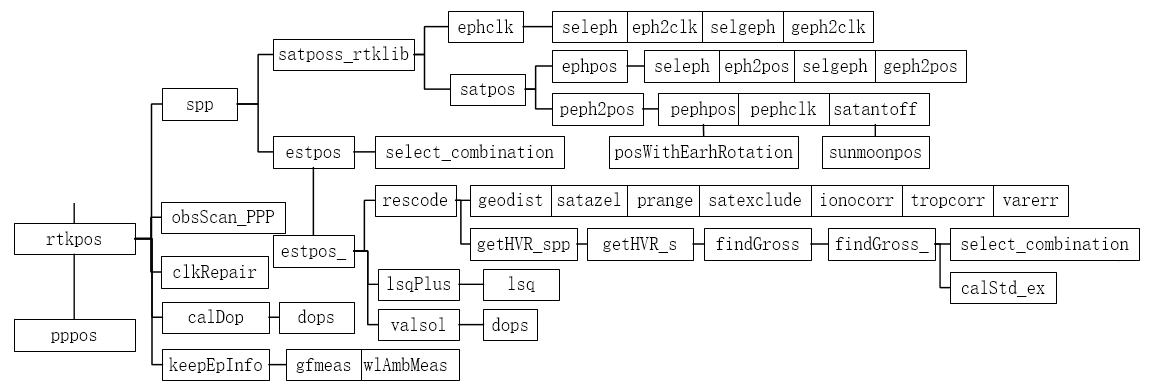
- 至此已经读完了文件,开始进行逐历元解算,先调用
spp()进行 SPP 解算。 - 调用
obsScan_PPP()观测值检测。 - 调用
clkRepair()修复钟跳。 - 调用
pppos()进行 PPP 解算。 - 调用
calDop()计算各种 DOP 值。 - 调用
keepEpInfo()存储当前历元的信息,其中会调用gfmeas()、wlAmbMeas()。
static int rtkpos(rtk_t *rtk, obsd_t *obs, int n, const nav_t *nav)
{
gtime_t time;
int nu;
char msg[128]="";
prcopt_t *opt=&rtk->opt;
rtk->sol.stat=SOLQ_NONE;
time=rtk->sol.time; /* previous epoch */
PPP_Glo.bOKSPP=1;
// 先调用 spp() 进行 SPP 解算流动站坐标,作为 PPP 初值
/* rover position by single point positioning */
if (!spp(obs,n,nav,opt,&rtk->sol,NULL,rtk->ssat,msg)) {
sprintf(PPP_Glo.chMsg,"*** ERROR: point pos error (%s)\n",msg);
outDebug(OUTWIN,OUTFIL,0);
PPP_Glo.bOKSPP=0;
PPP_Glo.nBadEpSPP++;
//fewer than 4 satellites available, skip to next epoch
if (n<=4) {
return -1;
}
}
// 计算和上一历元间时间间隔
if (time.time!=0) rtk->tt=timediff(rtk->sol.time,time);
// 调用 obsScan_PPP() 观测值检测
nu=n;
obsScan_PPP(opt,obs,n,&nu);
if (nu<=4) {
sprintf(PPP_Glo.chMsg, "*** WARNING: There are only %d satellites observed, skip PPP!\n",nu);
outDebug(OUTWIN,OUTFIL,0);
return 0;
}
// 调用 clkRepair() 修复钟跳
//clock jump repair
clkRepair(obs,nu);
// 调用 pppos() 进行 PPP 解算
/* precise point positioning */
if (opt->mode>=PMODE_PPP_KINEMA) {
pppos(rtk,obs,nu,nav);
}
else return 1;
// 调用 calDop() 计算各种 DOP 值
//calculate DOPs
calDop(rtk,obs,nu);
// 调用 keepEpInfo() 存储当前历元的信息,其中会调用 gfmeas()、wlAmbMeas()
//save the information for current epoch
keepEpInfo(rtk,obs,nu,nav);
return 1;
}
四、RINEX 文件读取
1、readobsnav():Rinex 文件读取主入口函数
gtime_t ts 解算开始时间
gtime_t te 解算结束时间
double ti 解算时间间隔
char **infile 传入文件路径数组
const int *index 对应文件下标
int n infile[]元素个数
const prcopt_t *prcopt 处理选项
obs_t *obs 存观测数据OBS
nav_t *nav 存导航电文数据NAV
sta_t *sta 测站结构体,存obs文件头读取到的一部分的信息
index[]的作用:会传给
execses_b(),再传给execses_r(),再传给execses(),再传给readobsnav()。如果不需要根据 tu 分时间段解算,index 存的就是 0~n,如果需要分时间段解算,index 存的是对应时间段内文件的下标。
-
先初始化 obs、nav->eph、nav->geph;遍历
infile[],如果下标和上一次循环的不同,记录当前index[i]值到ind。调用readrnxt()读取文件,其先调用readrnxfile()读取文件,如果测站名字为空,就给依据头文件自动赋 4 个字符的名字。 -
然后判断是否有观测数据和星历数据,成功读取到数据,就调用
sortobs(),根据 time、rcv、sat ,对obs->data的元素进行排序、去重,得到历元数nepoch。 -
最后调用
uniqnav(),其通过调用uniqeph()、uniqgeph()进行星历数据的排序去重,通过调用satwavelen()获取所有载波相位的波长到nav->lam。
static int readobsnav(gtime_t ts, gtime_t te, double ti, char *infile[MAXINFILE],
const int *index, int n, const prcopt_t *prcopt,
obs_t *obs, nav_t *nav, sta_t *sta)
{
int i,j,ind=0,nobs=0,rcv=1,nep;
// 初始化 obs、nav->eph、nav->geph
obs->data=NULL; obs->n =obs->nmax =0;
nav->eph =NULL; nav->n =nav->nmax =0;
nav->geph=NULL; nav->ng=nav->ngmax=0;
PPP_Glo.nEpoch=0;
// 遍历 infile[],调用readrnxt()读取文件
for (i=0;i<n;i++) {
// 如果下标和上一次循环的不同,记录当前index[i]值到ind
if (index[i]!=ind) {
if (obs->n>nobs) rcv++;
ind=index[i]; nobs=obs->n;
}
/* read rinex obs and nav file */
nep=readrnxt(infile[i],rcv,ts,te,ti,prcopt->rnxopt,obs,nav,rcv<=2?sta+rcv-1:NULL);
}
// 判断是否有观测数据和星历数据
if (obs->n<=0) {
printf("*** ERROR: no obs data!\n");
return 0;
}
if (nav->n<=0&&nav->ng<=0) {
printf("*** ERROR: no nav data!\n");
return 0;
}
// 调用sortobs(),根据 time、rcv、sat ,对 obs->data 的元素进行排序、去重,得到历元数nepoch
/* sort observation data */
PPP_Glo.nEpoch=sortobs(obs);
// 最后调用uniqnav(),其通过调用 uniqeph()、uniqgeph() 进行星历数据的排序去重,
// 通过调用 satwavelen() 获取所有载波相位的波长到 nav->lam。
/* delete duplicated ephemeris */
uniqnav(nav);
/* set time span for progress display */
if (ts.time==0||te.time==0) {
for (i=0; i<obs->n;i++) if (obs->data[i].rcv==1) break;
for (j=obs->n-1;j>=0;j--) if (obs->data[j].rcv==1) break;
if (i<j) {
if (ts.time==0) ts=obs->data[i].time;
if (te.time==0) te=obs->data[j].time;
settspan(ts,te);
}
}
// 判断有无 GLONASS 星历,为啥不放在前面???
if (prcopt->navsys&SYS_GLO) {
if (nav->ng<=0) {
printf("*** ERROR: nav->ng<=0!\n");
}
}
return 1;
}
extern int readrnxt(const char *file, int rcv, gtime_t ts, gtime_t te,
double tint, const char *opt, obs_t *obs, nav_t *nav,
sta_t *sta)
{
int i,stat=0;
const char *p;
char type=' ',*files[MAXEXFILE]={0};
/*if (!*file) {
return readrnxfp(stdin,ts,te,tint,opt,0,1,&type,obs,nav,sta);
}
for (i=0;i<MAXEXFILE;i++) {
if (!(files[i]=(char *)malloc(1024))) {
for (i--;i>=0;i--) free(files[i]);
return -1;
}
}*/
/* expand wild-card */
/*if ((n=expath(file,files,MAXEXFILE))<=0) {
for (i=0;i<MAXEXFILE;i++) free(files[i]);
return 0;
}*/
/* read rinex files */
//for (i=0;i<n&&stat>=0;i++) {
// 调用 readrnxfile() 读取文件
stat=readrnxfile(file,ts,te,tint,opt,0,rcv,&type,obs,nav,sta);
//}
// 如果测站名字为空,就给依据头文件自动赋 4 个字符的名字
/* if station name empty, set 4-char name from file head */
if (type=='O'&&sta) {
if (!(p=strrchr(file,FILEPATHSEP))) p=file-1;
if (!*sta->name) setstr(sta->name,p+1,4);
}
for (i=0;i<MAXEXFILE;i++) free(files[i]);
return stat;
}
2、readrnxfile():传入文件路径,读取起止时间内数据
-
如果传入了测站信息结构体 sta,调用
init_sta()初始化,值赋 0,指针赋空。 -
根据文件名判断文件来源(COD、IGS、IGR、GFZ、ESA、IAC、其它),以此设置 index。
-
以读的方式打开解压后的文件,调用
readrnxfp(),从文件描述符 fp 中读取文件,读完之后,关闭打开的文件描述符fp。
static int readrnxfile(const char *file, gtime_t ts, gtime_t te, double tint,
const char *opt, int flag, int index, char *type,
obs_t *obs, nav_t *nav, sta_t *sta)
{
FILE *fp;
int stat;
//char tmpfile[1024];
// 如果传入了测站信息结构体 sta,调用 init_sta() 初始化
if (sta) init_sta(sta);
// 判断文件名长度是否合理
if ( strlen(file)<2 )
return ' ';
// 以读的方式打开解压后的文件
if (!(fp=fopen(file,"r"))) {
return ' ';
}
// 根据文件名判断文件来源(COD、IGS、IGR、GFZ、ESA、IAC、其它),以此设置 index。
if (strstr(file,"cod")||strstr(file,"COD")) index=10;
else if (strstr(file,"igs")||strstr(file,"IGS")) index=9;
else if (strstr(file,"igr")||strstr(file,"IGR")) index=8;
else if (strstr(file,"gfz")||strstr(file,"GFZ")) index=7;
else if (strstr(file,"esa")||strstr(file,"ESA")) index=6;
else if (strstr(file,"iac")||strstr(file,"IAC")) index=-1;
else index=0;
// 调用 readrnxfp() ,从文件描述符 fp 中读取文件
/* read rinex file */
stat=readrnxfp(fp,ts,te,tint,opt,flag,index,type,obs,nav,sta);
// 读完之后,关闭打开的文件描述符 fp
fclose(fp);
/* delete temporary file */
//if (cstat) remove(tmpfile);
return stat;
}
4、readrnxfp():传入文件描述符,调用对应的读取函数
- 调用
readrnxh()读取头文件。并获取文件类型type。 - 根据
type调用对应的函数进行分类读取,readrnxobs()读观测文件,readrnxnav()读星历文件,调用readrnxnav()读钟差文件。
static int readrnxfp(FILE *fp, gtime_t ts, gtime_t te, double tint,
const char *opt, int flag, int index, char *type,
obs_t *obs, nav_t *nav, sta_t *sta)
{
double ver;
int sys,tsys;
char tobs[NUMSYS][MAXOBSTYPE][4]={{""}};
// 调用 readrnxh() 读取头文件。并获取文件类型 type
/* read rinex header */
if (!readrnxh(fp,&ver,type,&sys,&tsys,tobs,nav,sta)) return 0;
// flag 置 0 就不读钟差
/* flag=0:except for clock,1:clock */
if ((!flag&&*type=='C')||(flag&&*type!='C')) return 0;
// 根据 type 调用对应的函数进行分类读取
/* read rinex body */
switch (*type) {
case 'O': return readrnxobs(fp,ts,te,tint,opt,index,ver,tsys,tobs,obs);
case 'N': return readrnxnav(fp,opt,ver,sys ,nav);
case 'G': return readrnxnav(fp,opt,ver,SYS_GLO,nav);
case 'J': return readrnxnav(fp,opt,ver,SYS_QZS,nav); /* extension */
case 'L': return readrnxnav(fp,opt,ver,SYS_GAL,nav); /* extension */
case 'C': return readrnxclk(fp,opt,index,nav);
}
return 0;
}
5、readrnxh():读取文件头
- 函数的主体在一个 while 大循环中,循环读取每一行,直到出现 “END OF HEADER”
- 首先进行第一行版本号读取,记录版本号、卫星系统以及观测文件类型。
- PGM / RUN BY / DATE 跳过不读。
- 其它类型的行,根据文件类型,调用
decode_obsh()、decode_navh()、decode_gnavh()、decode_hnavh()、decode_navh()读取。

6、观测文件读取
1. decode_obsh():解析观测数据文件头
最关键的是解析观测值类型如下图,存到 tobs 三维数组中,【星座类型】【观测类型】【字符串数】 ,后面读文件体的时候要按文件头的观测值类型来读。
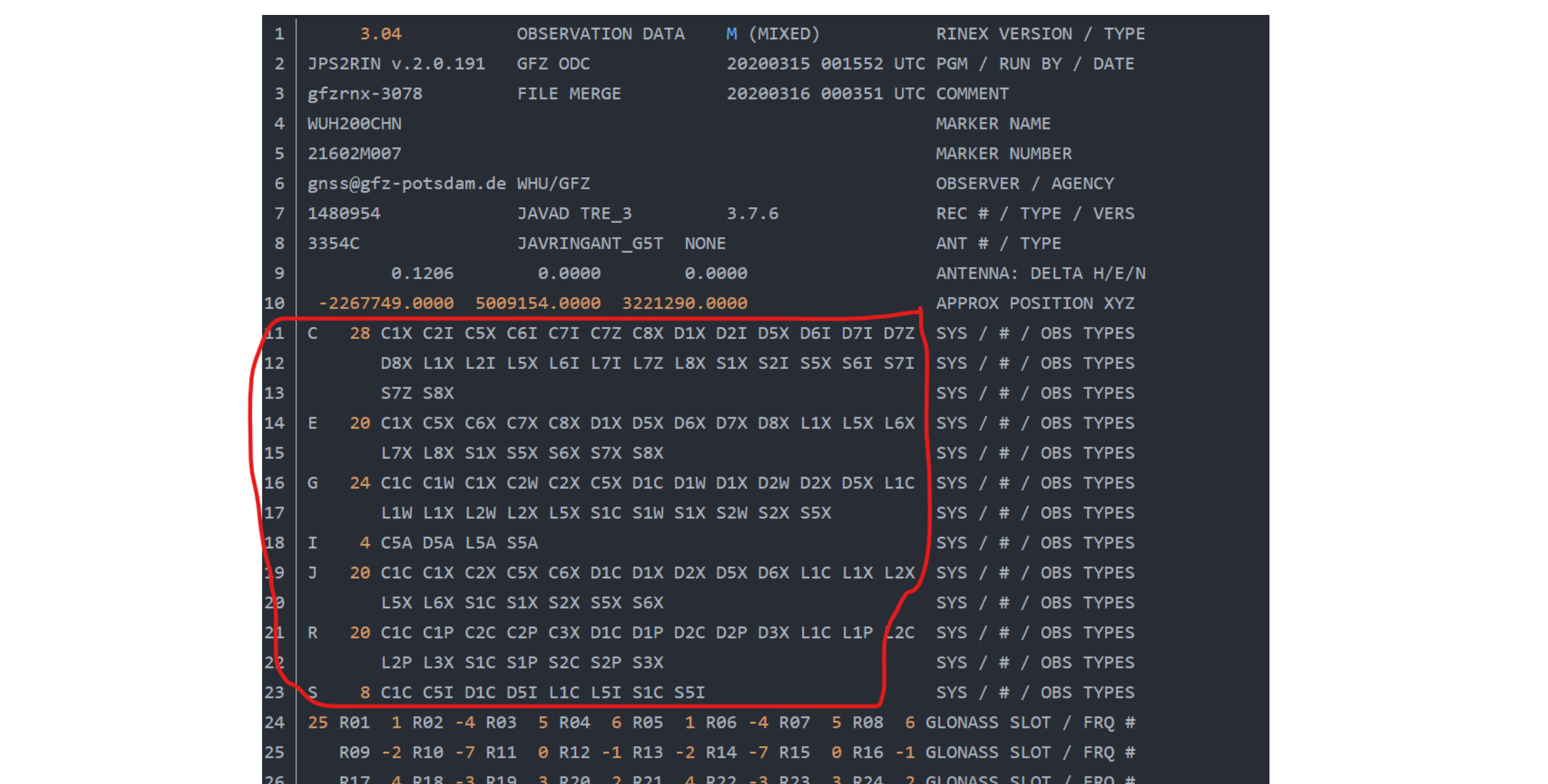
2. readrnxobs():读取o文件中全部观测值数据
重复调用readrnxobsb()函数,直到所有的观测值全被读完,或者是出现了某个历元没有卫星的情况为止
- 为
data[]开辟空间 - while大循环调用
readrnxobsb()每次读取一个历元的观测数据,获取观测值数n - 遍历
data[],如果时间系统为UTC,转为GPST,调用saveslips() - 调用
screent(),判断传入的时间是否符合起始时间ts,结束时间te,时间间隔tint - 遍历
data[],调用restslips(),addobsdata()将data[]信息存到obs中
3. readrnxobsb():读取一个观测历元的观测数据
-
调用
set_sysmask()获取卫星系统掩码mask,mask在之后decode_obsdata()中会用到,mask中没有的卫星系统不用。 -
调用set_index(),将将tobs数组中存的观测值类型信息存到sigind_t类型的index[]结构体数组中,此时传入的tobs数组是二维数组,每个传入的tobs都存了一个卫星系统的观测值类型,同理index[]的一个元素就存一个卫星系统的所有观测值类型。
-
while大循环,fgets()存一行的数据
- 如果是第一行,则调用
decode_obsepoch()函数解码首行数据(包括历元时刻、卫星数、卫星编号、历元状态等信息),并将信息保存 ,获取的卫星数量nsat是判断循环次数的关键。 - 如果不是第一行则调用
decode_obsdata()函数对该行观测数据进行数据解码,读取一个历元内一颗卫星的观测值 ,到data[n] - 知道读取数量 i 等于
decode_obsepoch()获取的卫星数量nsat,结束循环,返回读取的观测值数(卫星数)
- 如果是第一行,则调用
4. decode_obsepoch():解码历元首行数据
2、3版本观测值文件有区别:
-
2版本:

-
每历元首行数据前26位为历元时间(yy mm dd hh mm ss),年是 2 位表示,str2time() 函数中可以把年的前两位也补上。
-
29位epoch flag ,记录该历元状况,0表示正常,3:new site,4:header info,5:external event
-
30~32位为卫星数量
-
33~68:各个卫星的PRN号,观测到的卫星数>12时,一行的信息存储不下会自动换行,并且卫星的PRN号与前一行对其
-
历元信息往下一行就是记录观测值的数据块,以每颗卫星为单位,依照头文件中的观测值类型及顺序,从左到右依次排列,每行记录5个观测值,一行不够时转下行。当所有卫星数据记录完后,转到下一个历元。 观测值的顺序与文件头中**“SYS / # / OBS TYPES”**记录的观测类型顺序一致。
-
3版本:

- 每历元数据用用**>**开头
- 2~29位为历元时间(yyyy mm dd hh mm ss)
- 32位为 epoch flag
- 后面是接收机钟差(s)
- 每组数据中的每一行表示一颗卫星的观测值,观测值的顺序与文件头中**“SYS / # / OBS TYPES”**记录的观测类型顺序一致
-
执行流程:
- 2版本:
- 读取卫星数到
n - 读取
epoh flag到flag - 读取历元时间
time - 循环读取卫星ID(G10、G32、G26) ,读到68列,还没把卫星读完,就fgets()读取新的一行
- 将卫星ID转为
satellite number,存到sats[]数组中
- 读取卫星数到
- 3版本:
- 读取卫星数量
n - 读取
epoh flag到flag - 读取历元时间
time
- 读取卫星数量
5. decode_obsdata():读取一个历元内一颗卫星的观测值
- 3版本,读取卫星
satellite number存到obs->sat - 星系统和
mask做与运算,判断卫星系统是否启用 - 根据卫星系统分配索引
ind - 根据索引
ind中的观测值类型,循环读取观测值,读取一个历元内,一颗卫星的观测值,记录有效的观测值到val[i],记录记录信号失锁到lli[i] - 初始化
obs各观测值数组,赋空 - 遍历观测值类型,同频率的观测码,下标分别存到
k[],l[]中 ,p[]存频率索引,后面obs->P[0]就是利用L1载波观测到的伪距,obs->P[1]就是利用L2载波观测到的伪距 - 同一个频率有不同的观测码,取优先级高的
- 根据索引
ind中的观测值类型,遍历观测值,val[i]、lli[i]存入obs中
7、星历文件读取
1. decode_navh()、decode_gnavh()、decode_hnavh()
以decode_navh()为例:
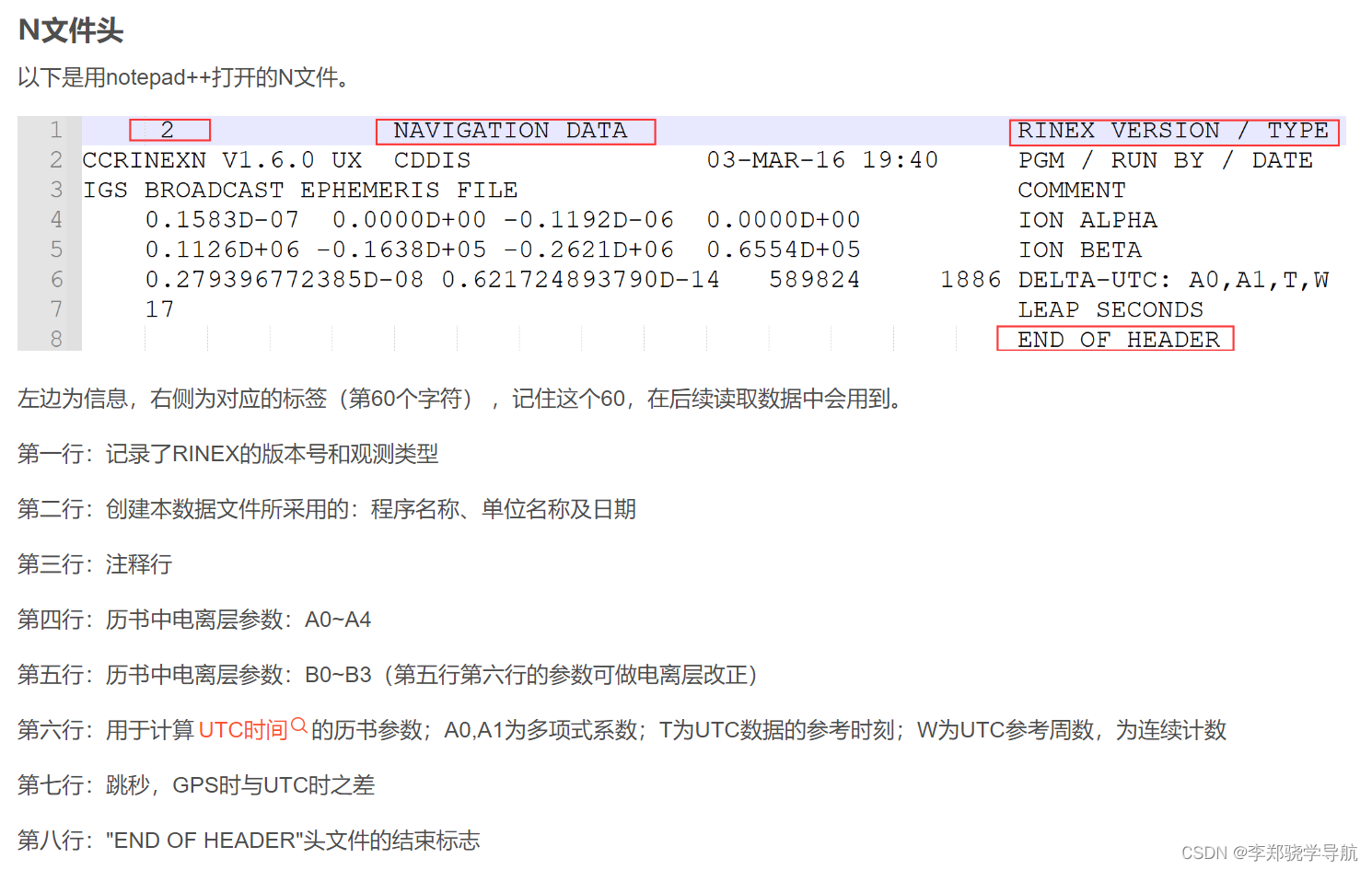
2. readrnxnav():读取星历文件,添加到nav结构体中
- add_eph():nav->eph[] 中添加 eph 星历数据,nav->n 表示 eph 数量。
- add_geph():nav->geph[] 中添加 GLONASS 星历数据,nav->ng 表示 geph 数量。
- add_seph():nav->seph[] 中添加 SBAS 星历数据,nav->ns 表示 seph 数量。
3. readrnxnavb():读取一个历元的星历数据,添加到 eph 结构体中
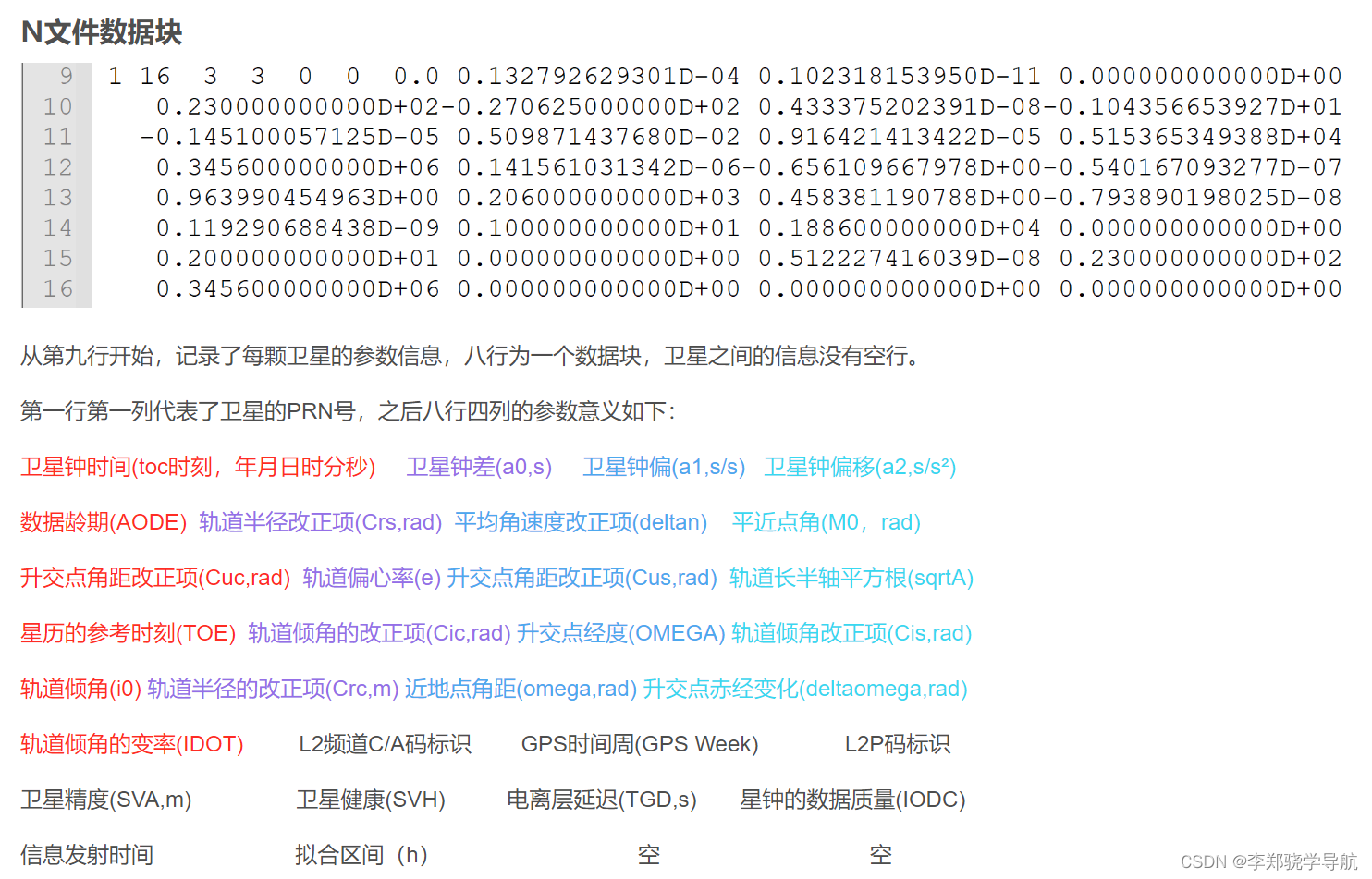
-
调用
set_sysmask()获取卫星系统掩码 -
循环读取一行行,记录TOC,读取到
data[],i记录读取的数据数量,读够数量调用decode_eph()等函数赋值给eph_t结构体
8、钟差文件读取
五、卫星位置钟差计算
1、satposs_rtklib()
gtime_t teph I (gpst) 用于选择星历的时刻 (gpst)
obsd_t *obs I OBS观测数据
int n I OBS数
nav_t *nav I NAV导航电文
int ephopt I 星历选项 (EPHOPT_???)
double *rs O 卫星位置和速度,长度为6*n,{x,y,z,vx,vy,vz}(ecef)(m,m/s)
double *dts O 卫星钟差,长度为2*n, {bias,drift} (s|s/s)
double *var O 卫星位置和钟差的协方差 (m^2)
int *svh O 卫星健康标志 (-1:correction not available)

遍历观测数据,找伪距观测值,除以光速得到信号传播时间,用数据接收时刻减去伪距信号传播时间得到信号发射时刻。
调用 ephclk() 函数,由广播星历计算出当前观测卫星与 GPS 时间的钟差 dt ,此时的钟差是没有考虑相对论效应和 TGD 的 ,dt 仅作为satpos()的参数,不作为最终计算的钟差。信号发射时刻减去钟差 dt,得到 GPS 时间下的卫星信号发射时刻。
调用 satpos() 对此观测值进行下一步卫星位置钟差的计算;satpos() 函数对星历计算选项进行判断,广播星历模式调用 ephpos(),精密星历模式调用 peph2pos()。最后检测钟差值,如果没有精密星历,则调用 ephclk() 用广播星历计算钟差。
extern void satposs_rtklib(gtime_t teph, const obsd_t *obs, int n, const nav_t *nav,
int ephopt, double *rs, double *dts, double *var, int *svh)
{
gtime_t time[MAXOBS]={{0}};
double dt,pr;
int i,j;
for (i=0;i<n&&i<2*MAXOBS;i++) {
for (j=0;j<6;j++) rs [j+i*6]=0.0;
for (j=0;j<2;j++) dts[j+i*2]=0.0;
var[i]=0.0; svh[i]=0;
/* search any psuedorange */
for (j=0,pr=0.0;j<NFREQ;j++) if ((pr=obs[i].P[j])!=0.0) break;
if (j>=NFREQ) {
sprintf(PPP_Glo.chMsg,"*** WARNING: no pseudorange %s sat=%2d\n",
time_str(obs[i].time,3),obs[i].sat);
outDebug(OUTWIN,OUTFIL,0);
continue;
}
/* transmission time by satellite clock */
time[i]=timeadd(obs[i].time,-pr/CLIGHT);
/* satellite clock bias by broadcast ephemeris */
if (!ephclk(time[i],teph,obs[i].sat,nav,&dt)) {
sprintf(PPP_Glo.chMsg,"*** WARNING: no broadcast clock %s sat=%2d\n",
time_str(time[i],3),obs[i].sat);
outDebug(0,OUTFIL,0);
continue;
}
time[i]=timeadd(time[i],-dt);
/* satellite position and clock at transmission time */
if (!satpos(time[i],teph,obs[i].sat,ephopt,nav,rs+i*6,dts+i*2,var+i,
svh+i)) {
sprintf(PPP_Glo.chMsg,"*** WARNING: no ephemeris %s sat=%2d\n",
time_str(time[i],3),obs[i].sat);
outDebug(0,0,0);
continue;
}
/* if no precise clock available, use broadcast clock instead */
if (dts[i*2]==0.0) {
if (!ephclk(time[i],teph,obs[i].sat,nav,dts+i*2)) continue;
dts[1+i*2]=0.0;
*var=SQR(STD_BRDCCLK);
}
}
}
2、ephclk()

单观测值卫星钟差计算。由于 GLONASS 系统的计算和其它的区别较大,先进行判断。
如果不是 GLONASS 则调用 seleph() 选择与观测值对应的星历,调用 eph2clk() 根据广播星历参数
a
0
a_0
a0、
a
1
a_1
a1、
a
2
a_2
a2 计算卫星钟差(迭代 3 次);
如果是 GLONASS 则调用 selgeph() 选择与观测值对应的星历,调用 geph2clk() 根据广播星历参数
t
a
u
n
t_aun
taun、
g
a
u
n
g_aun
gaun 计算卫星钟差(迭代 3 次)。
static int ephclk(gtime_t time, gtime_t teph, int sat, const nav_t *nav,
double *dts)
{
eph_t *eph;
geph_t *geph;
int sys;
sys=satsys(sat,NULL);
if (sys==SYS_GPS||sys==SYS_GAL||sys==SYS_QZS||sys==SYS_CMP) {
if (!(eph=seleph(teph,sat,-1,nav))) return 0;
*dts=eph2clk(time,eph);
}
else if (sys==SYS_GLO) {
if (!(geph=selgeph(teph,sat,-1,nav))) return 0;
*dts=geph2clk(time,geph);
}
else return 0;
return 1;
}
3、ephpos()

与 ephclk() 同理,由于 GLONASS 系统的计算和其它的区别较大,先进行判断。
如果不是 GLONASS 则调用 seleph() 选择与观测值对应的星历,调用 eph2pos() 根据广播星历中的开普勒轨道参数和摄动改正计算卫星位置(对北斗 MEO、IGSO 卫星会进行特殊处理)、校正卫星钟差的相对论效应、调用 var_uraeph() 用 URA 值来标定方差。
如果是 GLONASS 则调用 selgeph() 选择与观测值对应的星历,调用 geph2pos() 根据广播星历中 PZ-90 坐标系下卫星状态向量四阶龙格库塔迭代计算卫星位置。
计算完一次位置之后,加上一个极小的时间,再计算一次位置,两次计算出的时间作差求得卫星速度钟漂。
static int ephpos(gtime_t time, gtime_t teph, int sat, const nav_t *nav,
int iode, double *rs, double *dts, double *var, int *svh)
{
eph_t *eph;
geph_t *geph;
double rst[3],dtst[1],tt=1E-3;
int i,sys;
sys=satsys(sat,NULL);
*svh=-1;
if (sys==SYS_GPS||sys==SYS_GAL||sys==SYS_QZS||sys==SYS_CMP) {
if (!(eph=seleph(teph,sat,iode,nav))) return 0;
eph2pos(time,eph,rs,dts,var);
time=timeadd(time,tt);
eph2pos(time,eph,rst,dtst,var);
*svh=eph->svh;
}
else if (sys==SYS_GLO) {
if (!(geph=selgeph(teph,sat,iode,nav))) return 0;
geph2pos(time,geph,rs,dts,var);
time=timeadd(time,tt);
geph2pos(time,geph,rst,dtst,var);
*svh=geph->svh;
}
else return 0;
/* satellite velocity and clock drift by differential approx */
for (i=0;i<3;i++) rs[i+3]=(rst[i]-rs[i])/tt;
dts[1]=(dtst[0]-dts[0])/tt;
return 1;
}
4、peph2pos()

调用 pephpos() 根据精密星历计算卫星位置钟差,其中先二分查找时间最接近的精密星历,然后地球自转改正,调用 interppol() 内维尔插值获取卫星位置、线性插值获取钟差,最后计算标准差。
调用 pephclk() 根据精密星历计算卫星位置钟差,其中先二分查找时间最接近的精密钟差,再线性插值获取钟差、计算标准差。
计算相对论效应改正量,调用 satantoff() 计算卫星天线相位偏差改正。加上改正量得到卫星位置钟差。
加上一个极小的时间,再计算一次位置,两次计算出的时间作差求得卫星速度钟飘。
extern int peph2pos(gtime_t time, int sat, const nav_t *nav, int opt,
double *rs, double *dts, double *var)
{
double rss[3],rst[3],dtss[1],dtst[1],dant[3]={0},vare=0.0,varc=0.0,tt=1E-3;
int i;
if (sat<=0||MAXSAT<sat) return 0;
/* satellite position and clock bias */
if (!pephpos(time,sat,nav,rss,dtss,&vare,&varc)||
!pephclk(time,sat,nav,dtss,&varc)) return 0;
time=timeadd(time,tt);
if (!pephpos(time,sat,nav,rst,dtst,NULL,NULL)||
!pephclk(time,sat,nav,dtst,NULL)) return 0;
/* satellite antenna offset correction */
if (opt) {
satantoff(time,rss,sat,nav,dant);
}
for (i=0;i<3;i++) {
rs[i ]=rss[i]+dant[i];
rs[i+3]=(rst[i]-rss[i])/tt;
}
/* relativistic effect correction */
if (dtss[0]!=0.0) {
dts[0]=dtss[0]-2.0*dot(rs,rs+3,3)/CLIGHT/CLIGHT;
dts[1]=(dtst[0]-dtss[0])/tt;
}
else /* no precise clock */
dts[0]=dts[1]=0.0;
*var=vare+varc;
return 1;
}
。
计算相对论效应改正量,调用 satantoff() 计算卫星天线相位偏差改正。加上改正量得到卫星位置钟差。
加上一个极小的时间,再计算一次位置,两次计算出的时间作差求得卫星速度钟飘。
extern int peph2pos(gtime_t time, int sat, const nav_t *nav, int opt,
double *rs, double *dts, double *var)
{
double rss[3],rst[3],dtss[1],dtst[1],dant[3]={0},vare=0.0,varc=0.0,tt=1E-3;
int i;
if (sat<=0||MAXSAT<sat) return 0;
/* satellite position and clock bias */
if (!pephpos(time,sat,nav,rss,dtss,&vare,&varc)||
!pephclk(time,sat,nav,dtss,&varc)) return 0;
time=timeadd(time,tt);
if (!pephpos(time,sat,nav,rst,dtst,NULL,NULL)||
!pephclk(time,sat,nav,dtst,NULL)) return 0;
/* satellite antenna offset correction */
if (opt) {
satantoff(time,rss,sat,nav,dant);
}
for (i=0;i<3;i++) {
rs[i ]=rss[i]+dant[i];
rs[i+3]=(rst[i]-rss[i])/tt;
}
/* relativistic effect correction */
if (dtss[0]!=0.0) {
dts[0]=dtss[0]-2.0*dot(rs,rs+3,3)/CLIGHT/CLIGHT;
dts[1]=(dtst[0]-dtss[0])/tt;
}
else /* no precise clock */
dts[0]=dts[1]=0.0;
*var=vare+varc;
return 1;
}






